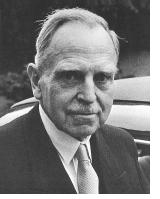Otto Hahn
chemist, b. 8 March 1879 (Frankfurt am Main, Germany), d. 28 July 1968 (Göttingen)
 Otto Hahn's father, a glazier, had wanted his son to become an architect, but the 18 year old Otto enrolled at the University of Marburg in chemistry. He had wide-ranging interests and attended lectures in Marburg and Munich not only in chemistry but also in art and philosophy. He obtained his Ph.D. in Marburg in 1901 and became an assistant in the Chemical Institute of the university.
Otto Hahn's father, a glazier, had wanted his son to become an architect, but the 18 year old Otto enrolled at the University of Marburg in chemistry. He had wide-ranging interests and attended lectures in Marburg and Munich not only in chemistry but also in art and philosophy. He obtained his Ph.D. in Marburg in 1901 and became an assistant in the Chemical Institute of the university.
The next five years were spent at the University College in London, where a task to prepare pure radium salts led to the discovery of radiothorium, and at McGill University in Montreal (Canada), where he worked with Ernest Rutherford on alpha rays and discovered radioactinium.
In 1906 Hahn moved to the Chemical Institute of the University of Berlin. In the following year Lise Meitner arrived at the institute, and the chemist Hahn and the physicist Meitner began a most fruitful collaboration that lasted thirty years. Their joint work covered investigations on beta-rays, their absorbability, magnetic spectra, use of the radioactive recoil and much more, before Hahn was called for service in World War I and served as a chemical warfare specialist.
In 1918 Hahn resumed his collaboration with Meitner. Using radioactive methods he investigated the absorption and precipitation of the smallest quantities of substances, normal and abnormal formation of crystals and other chemical aspects of matter. When he learnt about the discovery of radioactivity by the Joliot-Curies he and Meitner concentrated on exposing uranium and thorium to neutron bombardment. Their interest was increased by Enrico Fermi's discovery in 1934 that the bombardment of uranium with neutrons produces several new radioactive substances. Fermi believed that the new substances were new elements. Hahn, Meitner and their colleague Strassmann performed experiments to verify this, but four years of work did not result in a sensible interpretation of their experiments.
Meitner was from a Jewish family, and in 1938 she had to emigrate from Germany to avoid persecution by the Hitler regime. Hahn met with Meitner secretly in Copenhagen in 1939. Together they devised new experiments. When Hahn performed them in Berlin they showed that the mysterious substance was barium and that the uranium atom had thus split into two lighter atoms. Hahn and Strassmann reported this in the Naturwissenschaften, and Meitner in collaboration with her nephew Otto Frisch gave the physical explanation in an article in Nature and called the process "fission."
The far-reaching implications of nuclear fission were immediately recognized. The Hitler regime established a group to study military applications but did not force Hahn to abandon his research at the university. He continued to study the separation of many elements and kinds of atoms that arise through fission.
After the end of the war the British government took Hahn to England, where he learnt that the Nobel Prize for Chemistry had been given to him (but not to Meitner) in 1944. He was allowed to return to Germany and became president of the Kaiser Wilhelm Society (later renamed Max Planck Society). He began to speak out against further testing of nuclear weapons and received many honours.
Reference
Nobel e-Museum, the Official Web Site of The Nobel Foundation (2004) Otto Hahn. http://www.nobel.se/chemistry/laureates/1944/hahn-bio.html (accessed 25 July 2004); based on Nobel Lectures. Chemistry 1942-1962, Elsevier Publishing Company, Amsterdam, 1964.
home
 Otto Hahn's father, a glazier, had wanted his son to become an architect, but the 18 year old Otto enrolled at the University of Marburg in chemistry. He had wide-ranging interests and attended lectures in Marburg and Munich not only in chemistry but also in art and philosophy. He obtained his Ph.D. in Marburg in 1901 and became an assistant in the Chemical Institute of the university.
Otto Hahn's father, a glazier, had wanted his son to become an architect, but the 18 year old Otto enrolled at the University of Marburg in chemistry. He had wide-ranging interests and attended lectures in Marburg and Munich not only in chemistry but also in art and philosophy. He obtained his Ph.D. in Marburg in 1901 and became an assistant in the Chemical Institute of the university.